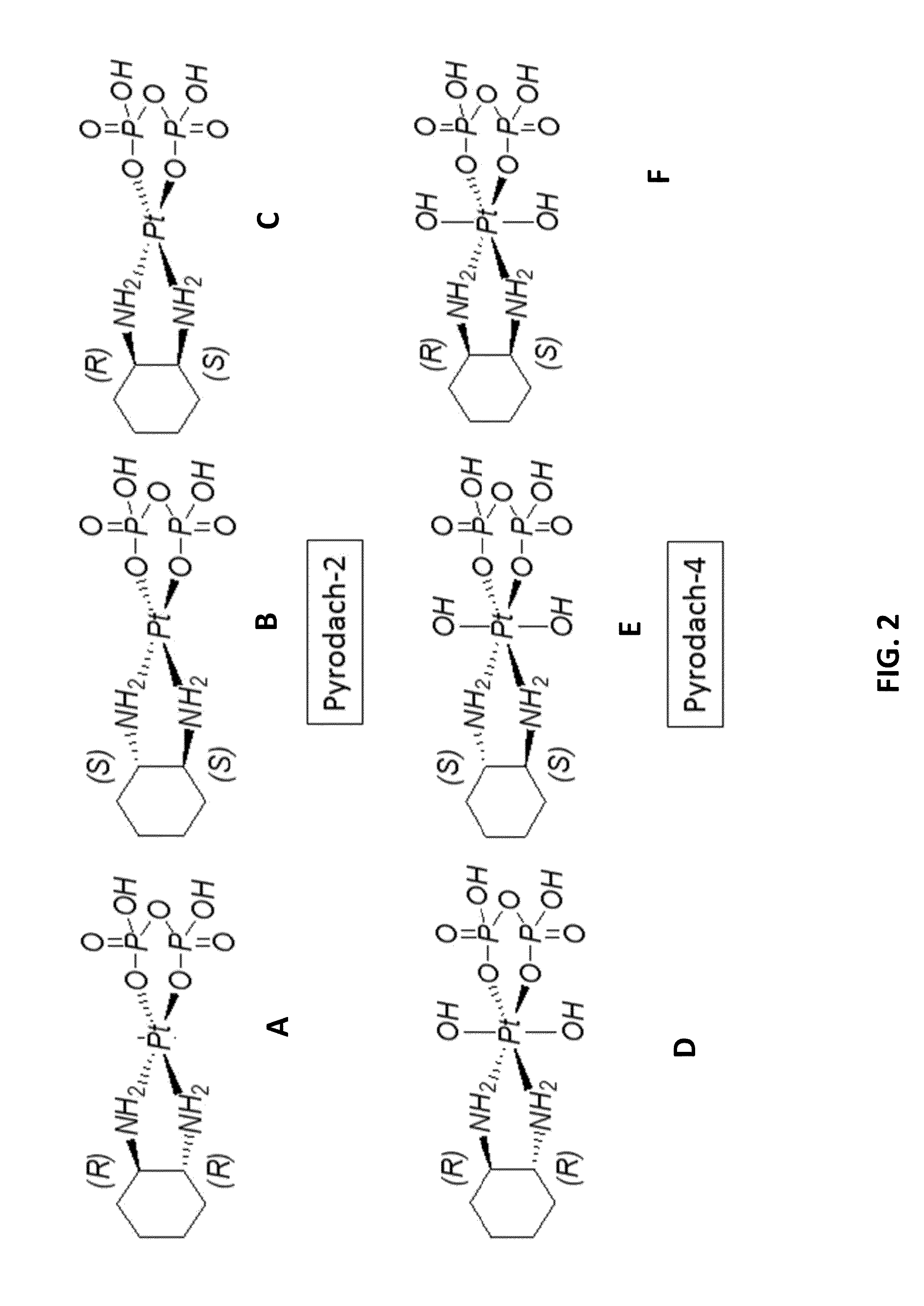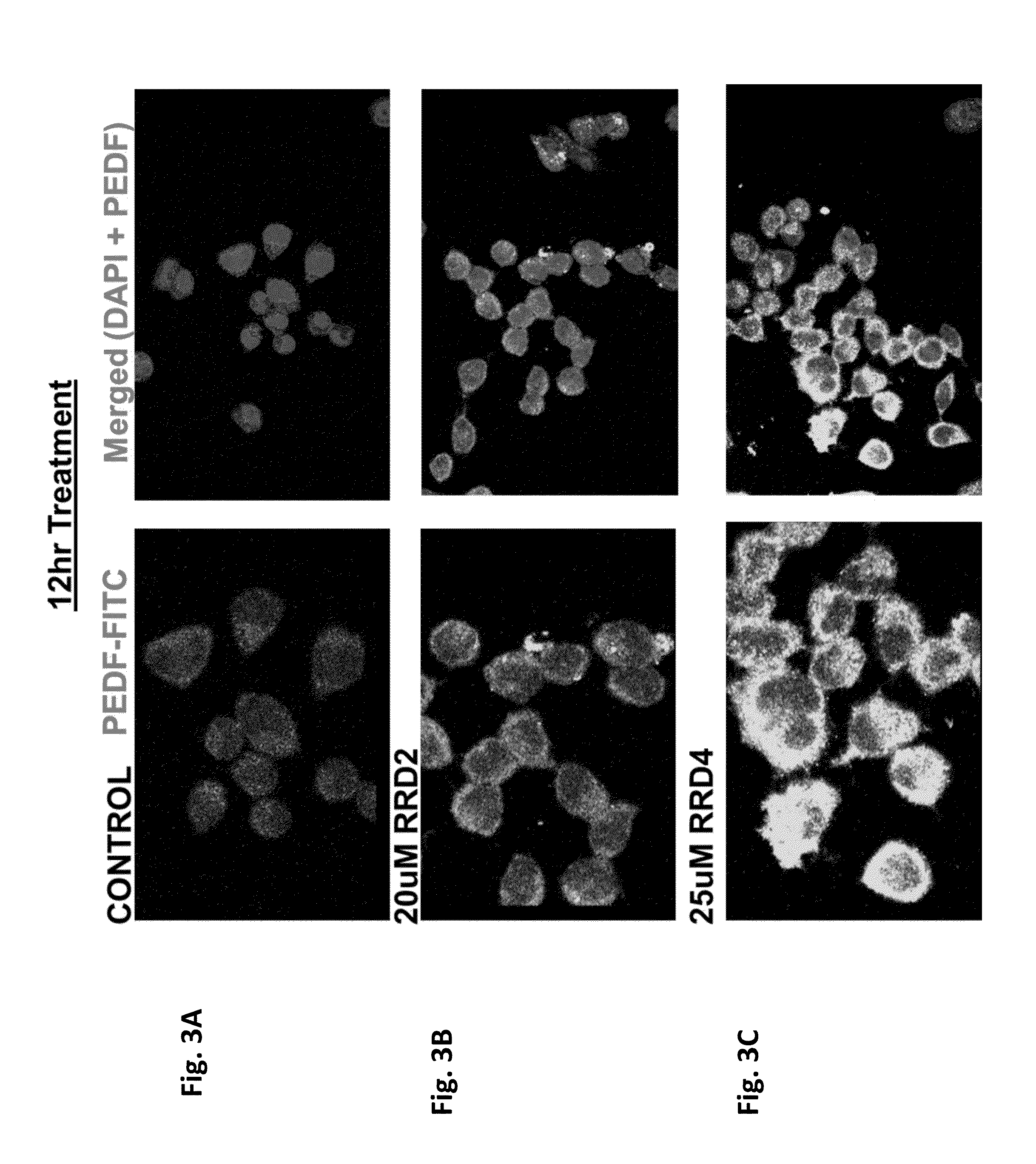Phosphaplatins as neuroprotective agents
a neuroprotective agent and phosphaplatin technology, applied in the field of phosphaplatin as neuroprotective agent, can solve the problems of limited aggressive cancer treatment, poor success rate of prior art methods for stabilizing pedf expression in vivo
- Summary
- Abstract
- Description
- Claims
- Application Information
AI Technical Summary
Benefits of technology
Problems solved by technology
Method used
Image
Examples
example 1
Overexpression of PEDF Gene in Human Cancer Cells
[0050]Human ovarian cancer cell lines, A2780 (Fox Chase) were cultured in 100 mm3 plates in monolayer by using RPMI medium 1640 supplemented with 10% FBS, 2 mM glutamine, 0.25 units / mL insulin and penicillin / streptomycin (100 units / ml) in a 37° C. incubator continuously gassed with 5% CO2. The cells were treated with either RRD2 and RRD4, 5 μM and 13 μM, respectively, for 24 hrs in triplicate. The cells were collected by 0.025% trypsin-edta and were centrifuged. The pellet of cells was then resuspended in PBS and washed three times with PBS and pelleted. The total RNA isolated using the Qiagen RNeasy Mini kit (Qiagen Inc.) according to the handbook protocol. The quantity of RNA was measured spectrophotometrically at Absorbance 260 nm (1Abs260=40 ug / ml) and the quality of RNA A260:A280 ratio was measured between 1.8 to 2.0. For each experiment, 0.9 μg of total RNA was converted to cDNA using the RT2 first strand kit (SABiosciences, Qia...
example 2
Phosphaplatin Mediated PEDF Protein Expression Determined by Immuno Fluorescence
[0052]A 6-well plate containing pretreated cover slips was seeded with 500-1000 cells of A2780 human ovarian cancer cell lines in 2.5 ml of RPMI 1640 media (Lonza Walkersville, Frederick, Md.) containing 2.0 mM L-glutamine and supplemented with 10% heat inactivated fetal bovine serum, FBS (Hyclone, Logan, Utah), and 0.25 units / mL recombinant human insulin (Sigma Aldrich, St. Louis, Mo.), 100 U / ml penicillin-streptomycin (Lonza Walkersville, Frederick, Md.). Those cells reaching to 80% confluency were treated with phosphaplatin compounds, RRD2 and RRD4 at various time intervals (3, 6, 12, or 24 hours). Each of the cover slip was washed with PBS three times, and the cells were fixed with freshly prepared 4% paraformaldehyde at room temperature for 20 minutes. The fixed cells were then washed with PBS for three times. These cells were permeablized and blocked with 7.5% bovine serum albumin, BSA / PBS / 0.01% tr...
example 3
Protein Expression by Western Blot
[0053]Treated human ovarian cancer cells (approximately 1×106 cells in 60 mm3 plates at 80-90% confluence) line with 20 μM RRD2 and 25 μM RRD4 for 3, 6 and 12 hrs was washed with PBS for three times. Total protein was extracted by treating the washed cells directly with 200 μl of RIPA (Sigma, St. Louis, Mo.) or MPER (Pierce, USA). Protein extract samples (50 μg) were separated by 12% SDS-PAGE and blotted onto polyvinylidene difluoride (PVDF) membranes. The blots were washed with TBST [10 mM Tris-HCl (pH 7.6), 150 mM NaCl, 0.1% Tween-20], blocked with 5% skim milk and 1% BSA overnight at 4 C, and incubated with the mouse anit-PEDF (Santa Cruz Biotechnology, USA) primary antibody at 1:500 dilutions in TBST with 5% skim milk and 1% BSA overnight at 4° C. The membrane was then washed TBST, and the primary antibodies were detected with secondary antibody goat anti-mouse IgG conjugated to horseradish peroxidase at 1:2500 dilution for 1.5 hours at room tem...
PUM
| Property | Measurement | Unit |
|---|---|---|
| Chemotherapeutic properties | aaaaa | aaaaa |
Abstract
Description
Claims
Application Information
 Login to View More
Login to View More - R&D
- Intellectual Property
- Life Sciences
- Materials
- Tech Scout
- Unparalleled Data Quality
- Higher Quality Content
- 60% Fewer Hallucinations
Browse by: Latest US Patents, China's latest patents, Technical Efficacy Thesaurus, Application Domain, Technology Topic, Popular Technical Reports.
© 2025 PatSnap. All rights reserved.Legal|Privacy policy|Modern Slavery Act Transparency Statement|Sitemap|About US| Contact US: help@patsnap.com



